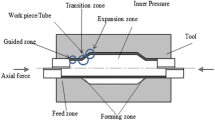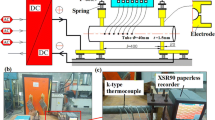Abstract
The automobile exhaust manifold regularly has a multi-valved shape that used to be formed by the combination of stamping and welding. The current study intended to investigate and develop a tube hydro-mechanical forming (THMF) process to form an integral automobile exhaust manifold that has the characters of large deformation and small corner. It included three stages such as pre-forming stage, die-forming stage, and calibration stage. In addition, the non-feasibility of one-step hydroforming process was proved by FE modeling and experimental for the target component. An optimal loading path was obtained through the principle of dichotomy for pre-forming stage and die-forming stage, corresponding to the maximum thinning ratio of 19.7% and 13.27% respectively. The variation of stress and strain states were analyzed for the whole process. As a consequent, the thickness distribution exhibited a V-shaped along axial direction at each stage, while a fluctuated distribution after die-forming was presented along radial direction in the multi-valved area. For the final component, a maximum thinning ratio of 28.53% and the large deformation above 60% obtained from FE modeling kept a reasonable agreement with that achieved from experiments. It showed that THMF has advantages of not only decreasing the internal pressure but also improving the formability of tube.
















Similar content being viewed by others
References
El-Aty AA, Xu Y, Guo XZ, Zhang SH, Ma Y, Chen DY (2018) Strengthening mechanisms, deformation behavior, and anisotropic mechanical properties of Al-Li alloys: a review. J Adv Res 10:49–67
He B, Tang W, Huang S, Hou SC, Cai HX (2016) Towards low-carbon product architecture using structural optimization for lightweight. Int J Adv Manuf Technol 83(5-8):1419–1429
Yuan SJ, Liu G, Huang XR, Wang XS, Xie WC, Wang ZR (2004) Hydroforming of typical hollow components. J Mater Process Technol 151(1-3):203–207
Dohmann F, Hartl C (1996) Hydroforming - a method to manufacture light-weight parts. J Mater Process Technol 60:669–676
Ahmetoglu M, Altan T (2000) Tube hydroforming: state-of-the-art and future trends. J Mater Process Technol 98(1):25–33
Kwan C, Lin F (2003) Investigation of T-shape tube hydroforming with finite element method. Int J Adv Manuf Technol 21(6):420–425
Kwan C, Lin C, Luo Y, Hu W, Jau T (2004) Die shape design for T-shape tube hydroforming. Int J Adv Manuf Technol 23(3-4):169–175
Asnafi N (1999) Analytical modelling of tube hydroforming. Thin-Walled Struct 34(4):295–330
Asnafi N, Skogsgårdh A (2000) Theoretical and experimental analysis of stroke-controlled tube hydroforming. Mater Sci Eng A 279(1-2):95–110
Koc M, Altan T (2002) Prediction of forming limits and parameters in the tube hydroforming process. Int J Mach Tools Manuf 42(1):123–138
Xu Y, Zhang SH, Cheng M, Song HW (2015) Formability improvement of austenitic stainless steel by pulsating hydroforming. Proc IMechE B J Eng Manuf 229(4):609–615
Ma Y, Xu Y, Zhang SH, Chen DY, El-Aty AA, Li JM, Chen GQ (2017) The effect of tube bending, heat treatment and loading paths on process responses of hydroforming for automobile intercooler pipe: numerical and experimental investigations. Int J Adv Manuf Technol 91(5-8):2369–2381
Chen DY, Xu Y, Zhang SH, Zhao ZJ, El-Aty AA, Ma Y, Li JM (2018) Evaluation of numerical and experimental investigations on the hybrid sheet hydroforming process to produce a novel high-capacity engine oil pan. Int J Adv Manuf Technol 97(9-12):3625–3636
Hwang YM, Hsieh SY, Kuo NJ (2017) Study of large-expansion-ratio tube hydroforming with movable dies. Key Eng Mater 725:616–622
Hwang YM, Hsieh SY, Chen MC (2015) Tube hydroforming of fuel filler pipes with movable dies. In Key Eng Mater Trans Tech Publ 626:524–528
Wada M, Iguchi K, Mizumura M, Kaneda H (2013) Weight reduction of axle-housings using high-expansion-ratio hydroforming technology. In Proceedings of the 6th international conference on tube hydroforming 68-72
Cogan RM (1963) Hydrodynamic compression forging. Gen Electric Company 111:7–890
Balendra R, Qin Y (2004) Injection forging: engineering and research. J Mater Process Technol 145(2):189–206
Qin Y, Ma Y, Balendra R (2004) Pressurising materials and process design considerations of the pressure-assisted injection forging of thick-walled tubular components. J Mater Process Technol 150(1-2):30–39
Chavdar B, Goldstein R, Ferguson L (2016) Hot hydroforging of lightweight bimaterial gears and hollow products. In 23rd IFHTSE Congress 18-22
Müller K, Stonis M, Lücke M, Behrens BA (2012) Hydroforging of thick-walled hollow aluminum profiles. In Key Eng Mater Trans Tech Publications 504:181–186
Xu Y, Ma Y, Zhang SH, Chen DY, Zhang XS, Li JM, Zhao ZJ (2016) Numerical and experimental study on large deformation of thin-walled tube through hydroforging process. Int J Adv Manuf Technol 87(5-8):1885–1890
Chu GN, Chen G, Lin YL, Yuan SJ (2017) Tube hydroforging− a method to manufacture hollow component with varied cross-section perimeters. J Mater Process Technol 265:150–157
Xu Y, Zhang SH, Cheng M, Song HW (2012) In situ X-ray diffraction study of martensitic transformation in austenitic stainless steel during cyclic tensile loading and unloading. Scr Mater 67(9):771–774
Strano M, Altan T (2004) An inverse energy approach to determine the flow stress of tubular materials for hydroforming applications. J Mater Process Technol 146(1):92–96
Kadkhodayan M, Erfani-Moghadam A (2012) an investigation of the optimal load paths for the hydroforming of T-shaped tubes. Int J Adv Manuf Technol 61(1-4):73–85
Huang TL, Song XW, Liu M (2016) The optimization of the loading path for T-shape tube hydroforming using adaptive radial basis function. Int J Adv Manuf Technol 82(9-12):1843–1857
Plancak M, Vollertsen F, Woitschig J (2005) Analysis, finite element simulation and experimental investigation of friction in tube hydroforming. J Mater Process Technol 170(1-2):220–228
Abdelkefi A, Malécot P, Boudeau N, Guermazi N, Haddar N (2017) Evaluation of the friction coefficient in tube hydroforming with the “corner filling test” in a square section die. Int J Adv Manuf Technol 88(5-8):2265–2273
Carleer B, Van Der Kevie G, De Winter L, Van Veldhuizen B (2000) Analysis of the effect of material properties on the hydroforming process of tubes. J Mater Process Technol 104(1-2):158–166
Acknowledgments
The authors extend sincere thanks and appreciation to Professor Asnafi Nader of ÖREBRO University (Sweden) for sustained advice and the language proofread.
Funding
The authors would like to acknowledge the financial support from the National Natural Science Foundation of China (Grand No. 51875548) and Natural Science Foundation of Liaoning Province of China (Grand No. 20180550851).
Author information
Authors and Affiliations
Corresponding author
Additional information
Publisher’s note
Springer Nature remains neutral with regard to jurisdictional claims in published maps and institutional affiliations.
Rights and permissions
About this article
Cite this article
Xia, LL., Xu, Y., El-Aty, A.A. et al. Deformation characteristics in hydro-mechanical forming process of thin-walled hollow component with large deformation: experimentation and finite element modeling. Int J Adv Manuf Technol 104, 4705–4714 (2019). https://doi.org/10.1007/s00170-019-04346-1
Received:
Accepted:
Published:
Issue Date:
DOI: https://doi.org/10.1007/s00170-019-04346-1




